Grevilleas for pot and small gardens – talk by Peter Olde
Saturday May 21st 2022, Gumnut community hall, Cherrybrook.
On Sat 21st May, 2022 at the APS NSW quarterly gathering, Peter Olde gave a talk titled: Grevilleas for pots and small gardens.
Peter started by saying he thinks that ‘small grevillea’ is an oxymoron because they are generally large plants. He commented that plants don’t conform to size, in that they aren’t limited by height or width but they keep growing through their lives. So they are limited by their lifespan, more than a specific physical limitation.
Peter approached this topic by talking about both new and some well known grevilleas that may be suitable for containers or for smaller spaces. He encouraged members to consider the vertical space above a small planting area, into which a grafted standard might be inserted. Grafted standards can be used in small gardens and as potted plants for the balcony or patio. He reminded us of the late Dot Gallagher who only ever wrote one article for the Grevillea Study Group Newsletter entitled ‘How to have a garden with one grevillea’. Building on that, standard grevilleas offer the opportunity to have a plant limited to the height at which it is sold and, depending on species, limited to some degree also in width. To end up with the ‘right’ plant for the space, and a list of suitably small plants he showed photos with the plants grafted as tall standards, small standards, and a few small species or cultivars plus a few surprises.
He encourages members to try grafting, and especially to try finding good rootstock for smaller plants. G. robusta is the ‘usual’ rootstock for larger plants. It is hardy in wet or moderately dry soils, poor drainage, sand or clay. However we don’t yet have a good answer for a solid performing smaller grevillea rootstock, especially those species or cultivars with simple leaves.
A number of these plants, especially the newer ones showcased here, may be difficult or impossible to get commercially. However, Peter recommends if you like any of them to ask at your local nursery (and then ask again!) because if nurseries get enough requests for a particular plant they may decide to try and stock it.
Firstly, some definitions of terms:
Graft – a horticultural technique whereby tissues of plants are joined so as to continue their growth together. The upper part of the combined plant is called the scion while the lower part is called the rootstock. Grafting can be used to produced standards or simply as a substitute, hardy rootstock.
Standard – using grafting to change the growth habit of a plant, usually a ground cover, to be more upright and ‘tree’ like so the branches and flowers trail down.
Small standard – see standard, but using a shorter rootstock.
Sp. Nov. – means the species is a new species (Nov = nova = new)
PBR – Plant Breeders Rights. A way that a breeder of a plant registers the plant so that other people are not allowed to propagate the plant for sale.
Slides shown (all photos by Peter Olde)
Grevillea masonii (small) Dalkeith fire station. A naturally small species. Not particularly showy but with a gorgeous combination of red and green flowers and soft undulate leaves. Hard to get.
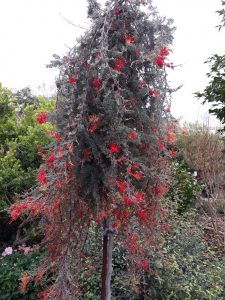
Grevillea humifusa. (Growing along ground). Sold years ago (from the late 1960s) as the Grey-leaf Prostrate form of G. thelemanniana. It was collected by the Kings Park plant collector and grown in Kings Park, Perth whence it spread into widespread horticulture. This turned out to be a new species with 3m long trailing branches. Try growing this one as a tall 2 m or 3 m standard. Flowers April-June bright red.
Grevillea leptobotrys – the plants we grow under this name are undescribed species. Only one population has been found of the type species (at Boyagarring Nature Reserve, W.A. where it is uncommon). Other populations are undescribed species including the one displayed in this picture from Dryandra Forest, W.A.. This plant is a very compact, dome-shaped plant in cultivation. Beautiful pink flowers in summer, must be grafted. A plant recently killed in Sydney’s recent extreme wet weather had to be sliced up like a cake to remove. There are around 10 different ‘forms’.
Grevillea nudiflora. Again long trailing peduncles along the ground in the wild and bird-pollinated. Grows 30 cm high and spreads. Photo displayed of standard Point Ann form with hanging peduncles bedecked with red and yellow flowers.
Grevillea ‘Carol Ann’. A small hardy plant that doesn’t need grafting. Can be grown as a tall or low standard, or simply planted in ground. Blood red (dark) flowers.
Grevillea ‘Honeyeater Heaven’. Ok in pot with no grafting, but not a long-lived species in Sydney. Parentage is G lanigera and G. alpina (the not hardy half) so may last a couple of years. G alpina hates humidity and associated fungi.
Grevillea sp. nov. ‘Maddens Plains’. This is a new species recently discovered in Maddens Plains south of Sydney, growing in moist soil in perched heath with condensed Hakea teretifolia and low Banksia. This is the first time members of the public are seeing photos of this plant. It is known from a single plant. It is definitely not a seedling of a known parent plant. It does look like G. macleayana but having a toothed leaf separates it from that species. It grows to around 1m. Mt Annan is propagating this plant now and chances are it will be hardy given its natural habitat in a temperate, summer-humid situation.
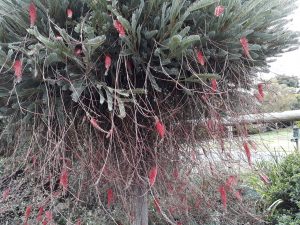
Grevillea dryandroides sends runners out with toothbrush inflorescences. It has fern-like leaves and disports its flowers in a wreath around the plant. It is a bird pollinated WA species. It makes an excellent standard on G. robusta, and the pedunculate inflorescences trail down.
Grevillea ‘Bonnie Prince Charlie’. Beautiful plant with an unfortunate sycophantic name that has little to do with plants. It comes from Victoria with a Mediterranean climate. This is a drop dead plant in the ground (in terms of mortality, not good looks!). It has to be in a pot to survive our Sydney climate.
Grevillea ‘Soopa Doopa’. Richard Tomkin hybridised this in QLD. This one doesn’t work well grafted. Unaffected by humidity. May be ok given it comes from a tropical climate. A low-growing cultivar with showy flowers over a long period. Makes an excellent pot plant as can be seen in slide.
Grevillea ‘Jelly Baby’. One of its parents is G. lavandulacea, a beautiful species with bright pink flowers. It came up as a seedling in Neil Marriott’s garden in western Victoria. Showy but not hardy in Sydney climate. Need to try and find good rootstock to work for this and similar plants.
Grevillea sp. nov. ‘Burrendong”. This hardy plant has been grown and sold at Burrendong Arboretum for over 50 years. Originally listed in their 1956 catalogue as ‘G. ericifolia’ (syn. G. lanigera) but when I saw it I realised it was closely related to G. rosmarinifolia. It was collected originally from the wild in New South Wales by George Althofer but in later years he was unable to remember where he found it. ‘Somewhere on the Lachlan, I think’. There are no specimens in any herbarium. I intend to describe this as Grevillea burrendong. It has beautiful pale pink flowers. The cultivated plants are the only extant plants and Chris Cheetham here today is selling some propagated from a plant in my garden.
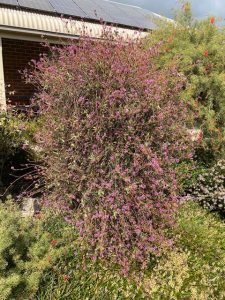
Grevillea quercifolia – WA species with pink, beautiful flowers. Likes shelter and prefers partial shade
Grevillea hislopii. WA species. Recently described (2008). A stunningly beautiful species related to G. buxifolia.
Grevillea ‘New Blood’. Has G. juniperina in its parentage. Radiant dark red flowers with a prostrate habit. Also makes a good standard.
Grevillea ‘Butterfly Beauty’. Came from WA cutting material, from a single plant in wild; maybe a hybrid? Soft foliage grows 1m dense to ground, is not a heavy flowering plant but has beautiful flowers and foliage. Brian Roach was selling plants today.
Grevillea scabra. When I first got interested in Grevillea, this WA species was thought to be extinct. Originally collected by James Drummond from which it was described in 1845, a single specimen was subsequently collected by Charles Gardner but could not be relocated because of his secretive ways. However over the years more populations have been found and we have grafted plants in cultivation. It makes an excellent garden plant when grafted on G. robusta and was unaffected in the recent big wet.
Grevillea calliantha (endangered) WA plant. Beautiful flowers, apricot centre with black styles.
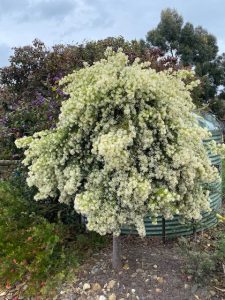
Grevillea lawrencenceana. An earlier name published in Germany for plants currently known as G. curviloba has been discovered and has forced a priority name change. Fifty years ago it was confused with G. biternata, another name by which it was once known. The plant formerly known as G. curviloba subsp. incurva will also get a new name. This species makes an excellent standard as can be seen in the image displayed.
Grevillea ‘Hills Jubilee’. This cultivar was selected by Hills Grammar School for their 25 year Jubilee celebrations from a batch of hybrids developed by Peter Ollerenshaw, Bywong Nursery, NSW. I think it has beautiful flowers which change in intensity under differing light conditions.
Grevillea mucronulata. Green flowers make it attractive to birds. This species needs a lot of taxonomic work, Peter thinks there should be populations described separately because they are quite different to each other in terms of form. The lignotuberous form with paler leaves from the Cumberland Plain is distinctive and lovely small, bird-attracting garden plant.
Grevillea lanigera – the plants sold as G. lanigera Mt Tamboritha come from Wilsons Promontory, not from Mt Tamboritha where the form is different. This is a hardy, relatively small ground cover. Can be clipped back, good for low growing, and is one of the first to flower in winter.
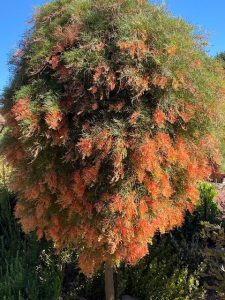
Grevillea tenuiloba is beautiful but very prickly. Grow it as a standard so you can get under it to tidy up, then when you prune it you sweep or vacuum the discarded foliage so you don’t get prickled. (Good luck with that). Flowers orange in masses.
Grevillea ‘Pink Midget’ – small plant that has been incredibly popular. It came up as a volunteer in the late Merv Hodge’s garden near Brisbane. It is a fairly inconspicuous pink-flowered small grevillea but its small size and hardiness resulted in the sale of thousands of plants.
Grevillea ‘Gold Touch’. Recently released by Bywong Nursery where it was bred. Parentage has G alpina. Hardy in Sydney conditions but did not tolerate recent extreme wet weather in my garden. Has very attractive red/yellow flowers. Pot culture suggested.
Grevillea obtusifolia. Not a showy plant but has lovely somewhat hidden pink-red flowers that are bird-attractive. Makes a great ground cover. Sadly this plant is becoming rare in the wild now. It is beautiful as a standard.
Grevillea thyrsoides. Shown in the presentation as a low graft but planted in a tall pot. Peduncles laden with dusky pink flowers cascading down over the edge of the pot.
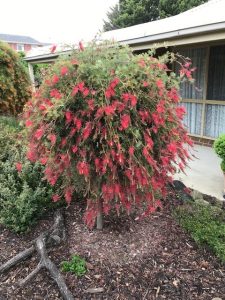
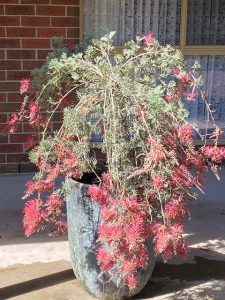
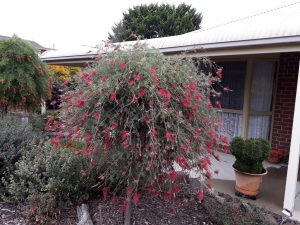
Finally, a question was asked: Why are white flowered grevilleas usually more strongly perfumed? Answer: White flowers are usually pollinated by insects and the perfume attracts them.
Wendy Grimm found G. speciosa in a white form in Kuringgai National Park. The thought was it is a genetic mutant, which can happen from time to time. Unfortunately that plant is no longer alive, but Peter hopes it may regrow one day perhaps after a fire in the area.
